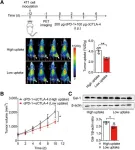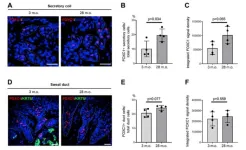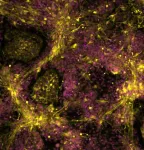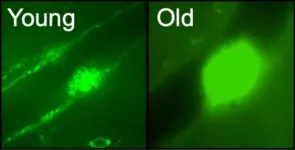(Press-News.org) Reston, VA—The protein galectin-1 (Gal-1) has been identified as a new PET imaging biomarker for immune checkpoint blockade (ICB) therapy, allowing physicians to predict the tumor responses before beginning treatment. Information garnered from Gal-1 PET imaging could also be used to facilitate patient stratification and optimize immunotherapy, enabling targeted interventions and improving patient outcomes. This research was published in the May issue of The Journal of Nuclear Medicine.
Immunotherapies, such as ICB, have produced promising clinical outcomes in melanoma, non–small cell lung cancer, and several other types of tumors. However, only a subgroup of patients experiences positive outcomes with objective response rates spanning between five and 60 percent.
“Developing reliable approaches for assessing responses and selecting eligible patients for immunotherapy remains challenging,” said Zhaofei Liu, PhD, Boya Distinguished Professor at Peking University in Beijing, China. “Current clinical criteria for monitoring solid tumor responses to immunotherapy are based on CT and MRI scans, but these methods result in a considerable delay between treatment commencement and response evaluation. Molecular imaging techniques, especially PET, have emerged as robust tools for predicting immunotherapy effectiveness through the real-time, quantitative, and noninvasive assessment of biomarkers in vivo.”
In the study, a mouse model was utilized to identify new imaging biomarkers for tumor responses to ICB therapy. Through a proteomic analysis (separation, identification, and quantification of proteins in a tumor), researchers found that tumors exhibiting low Gal-1 expression responded positively to ICB therapy.
Next, Gal-1 was labeled with 124I and the radiotracer (124I-α-Gal-1) and small animal PET imaging and biodistribution studies were conducted to assess the specificity of the radiotracer. PET imaging with 124I-αGal-1 showed the immunosuppressive status of the tumor microenvironment, thus enabling the prediction of ICB resistance in advance of treatment. For tumors that were not predicted to respond well to ICB therapy, researchers developed a rescue strategy that utilized a Gal-1 inhibitor that significantly improved the chance for success.
“Gal-1 PET opens avenues for the early prediction of ICB efficacy before treatment initiation and facilitates the precision design of combinational regimes,” noted Liu. “This sensitive approach has the potential to achieve individualized precision treatment for patients in the future.”
This research was published online in March 2024.
The authors of “Noninvasively Deciphering the Immunosuppressive Tumor Microenvironment Using Galectin-1 PET to Inform Immunotherapy Responses” include Ning Liu, Xiujie Yang, Chao Gao, Jianze Wang, Yuwen Zeng, Linyu Zhang, Qi Yin, Ting Zhang, Haoyi Zhou, Kui Li, and Jinhong Du, Department of Radiation Medicine, School of Basic Medical Sciences, Peking University Health Science Center, Beijing, China; Shixin Zhou, Department of Cell Biology, School of Basic Medical Sciences, Peking University Health Science Center, Beijing, China; Xuyang Zhao, Institute of Systems Biomedicine, Department of Pathology, School of Basic Medical Sciences, Peking University Health Science Center, Beijing, China; Hua Zhu and Zhi Yang, Key Laboratory of Carcinogenesis and Translational Research (Ministry of Education/Beijing), Department of Nuclear Medicine, Peking University Cancer Hospital and Institute, Beijing, China; and Zhaofei Liu, Key Laboratory of Carcinogenesis and Translational Research (Ministry of Education/Beijing), Department of Nuclear Medicine, Peking University Cancer Hospital and Institute, Beijing, China, Department of Nuclear Medicine, Peking University Third Hospital, Beijing, China, State Key Laboratory of Vascular Homeostasis and Remodeling, Peking University, Beijing, China, and Peking University–Yunnan Baiyao International Medical Research Center, Beijing, China.
Visit the JNM website for the latest research, and follow our new Twitter and Facebook pages @JournalofNucMed or follow us on LinkedIn.
###
Please visit the SNMMI Media Center for more information about molecular imaging and precision imaging. To schedule an interview with the researchers, please contact Rebecca Maxey at (703) 652-6772 or rmaxey@snmmi.org.
About JNM and the Society of Nuclear Medicine and Molecular Imaging
The Journal of Nuclear Medicine (JNM) is the world’s leading nuclear medicine, molecular imaging and theranostics journal, accessed more than 16 million times each year by practitioners around the globe, providing them with the information they need to advance this rapidly expanding field. Current and past issues of The Journal of Nuclear Medicine can be found online at http://jnm.snmjournals.org.
JNM is published by the Society of Nuclear Medicine and Molecular Imaging (SNMMI), an international scientific and medical organization dedicated to advancing nuclear medicine and molecular imaging—precision medicine that allows diagnosis and treatment to be tailored to individual patients in order to achieve the best possible outcomes. For more information, visit www.snmmi.org.
END
Newly identified PET biomarker predicts success of immune checkpoint blockade therapy
2024-05-14
ELSE PRESS RELEASES FROM THIS DATE:
Age-associated gene expression changes in mouse sweat glands
2024-05-14
“In this study, we first obtained evidence that, in mouse, aging primarily reduced the number of active sweat glands.”
BUFFALO, NY- May 14, 2024 – A new research paper was published in Aging (listed by MEDLINE/PubMed as "Aging (Albany NY)" and "Aging-US" by Web of Science) Volume 16, Issue 8, entitled, “Characterization of age-associated gene expression changes in mouse sweat glands.”
Evaporation of sweat on the skin surface is the major mechanism for dissipating heat in humans. The secretory capacity of sweat glands (SWGs) ...
26-year-old heart transplant and stroke survivor named national champion for women’s health
2024-05-14
DALLAS, May 13, 2024 — Fewer than half of all women are aware that heart disease is their leading cause of death. That is why the American Heart Association, celebrating one hundred years of lifesaving service, created its community-based Woman of Impact™ initiative as an outgrowth of its year-round Go Red for Women® activist movement. The movement spotlights the lack of awareness and the clinical care gaps in women’s heart health. This year’s National Winner of the Go Red for Women 2024 Woman of Impart initiative is a 26-year-old heart transplant recipient, stroke survivor and American Heart Association local volunteer, Hana Hooper from Puget ...
Virus that causes COVID-19 can penetrate blood-retinal-barrier and could damage vision
2024-05-14
The blood-retinal barrier is designed to protect our vision from infections by preventing microbial pathogens from reaching the retina where they could trigger an inflammatory response with potential vision loss. But researchers at the University of Missouri School of Medicine have discovered the virus that causes COVID-19 can breach this protective retinal barrier with potential long-term consequences in the eye.
Pawan Kumar Singh, PhD, an assistant professor of ophthalmology, leads a team researching new ways to prevent and treat ocular infectious diseases. Using a humanized ...
Stem cells provide new insight into genetic pathway of childhood cancer
2024-05-14
Scientists have discovered a new insight into the genetic pathway of childhood cancer, offering new hope for tailored treatments.
Researchers from the University of Sheffield have created a stem cell model designed to investigate the origins of neuroblastoma, a cancer primarily affecting babies and young children.
Neuroblastoma is the most common childhood tumour occurring outside the brain, affecting the lives of approximately 600 children in the European Union and the United Kingdom each year.
Until now, studying genetic changes and their role in neuroblastoma initiation has been challenging due to the lack of suitable laboratory ...
Distinct population of ‘troublemaker’ platelet cells appear with aging, lead to blood clotting, disease
2024-05-14
As people age, they become more prone to blood clotting diseases, when blood cells called platelets clump together when they don’t need to and can cause major issues such as strokes and cardiovascular disease. For decades, scientists have studied why older people’s blood cells behave in this way, using their insights to develop the myriad of blood-thinning drugs now on the market for treating the leading cause of death in the United States.
Now, UC Santa Cruz Professor of Biomolecular Engineering Camilla Forsberg and her research group have ...
2023 was the hottest summer in two thousand years
2024-05-14
Researchers have found that 2023 was the hottest summer in the Northern Hemisphere in the past two thousand years, almost four degrees warmer than the coldest summer during the same period.
Although 2023 has been reported as the hottest year on record, the instrumental evidence only reaches back as far as 1850 at best, and most records are limited to certain regions.
Now, by using past climate information from annually resolved tree rings over two millennia, scientists from the University of Cambridge and the Johannes Gutenberg University Mainz have shown how exceptional the summer of 2023 was.
Even allowing for natural climate variations over hundreds of years, 2023 was still ...
Analysis of previously unstudied areas of the human genome suggests people with more copies of ribosomal DNA have higher risks of developing disease
2024-05-14
UNDER STRICT EMBARGO UNTIL 4PM GMT (11AM ET) on 14 May 2024.
Peer reviewed | Observational | People
Ribosomal DNA (rDNA) is present in hundreds of copies in the genome, but has not previously been part of genetic analyses. A new study of 500,000 individuals indicates that people who have more copies of rDNA are more likely to develop inflammation and diseases during their lifetimes.
Standard genetic analysis techniques have not studied areas of the human genome that are repetitive, such as ribosomal ...
Study reveals mixed public opinion on polygenic embryo screening for IVF
2024-05-14
Three out of four U.S. adults support the use of emerging technologies that estimate a future child’s likelihood of developing health conditions influenced by multiple genes — such as diabetes, heart disease, and depression — before an embryo is implanted during in vitro fertilization (IVF), according to a new public opinion survey led by researchers at Harvard Medical School.
Results of the survey, to be published May 14 in JAMA Network Open, underscore the need for public education and conversation about the positive ...
Congenital anomalies are ten times more frequent in children with neurodevelopmental disorders
2024-05-14
Children with neurodevelopmental disorders report congenital abnormalities, such as defects of the heart and/or urinary tract, at least ten times more frequent compared to other children. This is one of the findings from an analysis from Radboud university medical center of data from over 50,000 children. Thanks to this new database, it's now much clearer which health problems are associated with a particular neurodevelopmental disorder and which are not. The study has been published in Nature Medicine.
Two to three percent of the population have a neurodevelopmental disorder, such as autism or intellectual ...
Does pharmacological treatment of ADHD reduce criminality?
2024-05-14
May 14 2024 – A study in the Journal of the American Academy of Child and Adolescent Psychiatry (JAACAP), published by Elsevier, found that pharmacological treatment of attention-deficit/hyperactivity disorder (ADHD) reduced violence- and public-order related crimes. However, it did not reduce other types of crimes, among patients with ADHD in early to late adolescence considered to be in the grey zone (or on the margin) for such treatment.
This study uses variation in healthcare providers treatment preference as the basis for a quasi-experimental design that examines the effect of pharmacological ...






